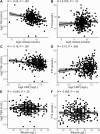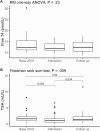Thyroid Function Before, During, and After COVID-19
- PMID: 33180932
- PMCID: PMC7823247
- DOI: 10.1210/clinem/dgaa830
Thyroid Function Before, During, and After COVID-19
Abstract
Context: The effects of COVID-19 on the thyroid axis remain uncertain. Recent evidence has been conflicting, with both thyrotoxicosis and suppression of thyroid function reported.
Objective: We aimed to detail the acute effects of COVID-19 on thyroid function and determine if these effects persisted on recovery from COVID-19.
Design: A cohort observational study was conducted.
Participants and setting: Adult patients admitted to Imperial College Healthcare National Health Service Trust, London, UK, with suspected COVID-19 between March 9 to April 22, 2020, were included, excluding those with preexisting thyroid disease and those missing either free thyroxine (FT4) or thyrotropin (TSH) measurements. Of 456 patients, 334 had COVID-19 and 122 did not.
Main outcome measures: TSH and FT4 measurements were recorded at admission, and where available, in 2019 and at COVID-19 follow-up.
Results: Most patients (86.6%) presenting with COVID-19 were euthyroid, with none presenting with overt thyrotoxicosis. Patients with COVID-19 had a lower admission TSH and FT4 compared to those without COVID-19. In the COVID-19 patients with matching baseline thyroid function tests from 2019 (n = 185 for TSH and 104 for FT4), TSH and FT4 both were reduced at admission compared to baseline. In a complete case analysis of COVID-19 patients with TSH measurements at follow-up, admission, and baseline (n = 55), TSH was seen to recover to baseline at follow-up.
Conclusions: Most patients with COVID-19 present with euthyroidism. We observed mild reductions in TSH and FT4 in keeping with a nonthyroidal illness syndrome. Furthermore, in survivors of COVID-19, thyroid function tests at follow-up returned to baseline.
Keywords: COVID-19; SARS-CoV-2; thyroid function; thyroid gland.
© The Author(s) 2020. Published by Oxford University Press on behalf of the Endocrine Society.
Figures



References
-
- Wei L, Sun S, Zhang J, et al. . Endocrine cells of the adenohypophysis in severe acute respiratory syndrome (SARS). Biochem Cell Biol. 2010;88(4):723-730. - PubMed
Publication types
MeSH terms
Substances
Grants and funding
LinkOut - more resources
Full Text Sources
Medical
Miscellaneous

